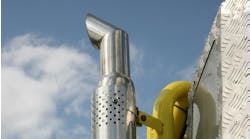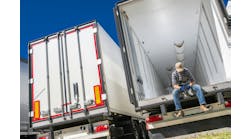Did you know that a single accident can cost your company hundreds, if not thousands of dollars, in repairs, downtime, and increased insurance premiums? According to the NHTSA, the cause of 94 percent of collisions is driver behavior error.
How do you know what mistakes your drivers are making? Driving behaviors such as speeding, hard braking, sharp turns, and quick lane changes can put your drivers at risk of getting into an accident. Preventing these accidents, and avoiding risky driver behaviors across your entire fleet, can seem impossible, but with fleet safety management software it’s simple.
Using fleet safety management software, fleets can monitor driver actions behind the wheel. With these insights, you can pinpoint problematic driver behaviors and develop personalized training to correct the issues.
What causes unsafe driving behaviors?
Factors that influence driver behavior such as other drivers on the road can contribute to the development of unsafe driving behavior. Unsafe driving habits are everywhere, and like most other things, people tend to mimic the actions of others around them including competitive and dangerous driving behaviors. While this sounds like a problem, drivers can just as easily be taught that safe driving behavior is normal.
In fact, studies have shown that drivers have a desire to conform to what they perceive to be normal driving behavior. “People like to ‘fit in’ with what is normal, so rather than highlighting the fact that lots of people admit to using their phone occasionally, why not highlight the fact that, at any point in time, the clear majority of people do not use their phone while driving?” By showing drivers that the average safe driver does not check their phone, speed or brake hard, you can influence drivers to be safer on the road.
Even the most experienced drivers can develop unsafe driver behaviors. Commercial drivers are not immune to the influences of other people or media, and because they spend so much time behind the wheel, they need to ensure that they are ignoring those unsafe impulses.
Distracted driving is a leading cause of risky driver behaviors. Commercial drivers and regular drivers are distracted by cell phone usage, consuming food and beverages and even driver fatigue every day.
Commercial drivers who are on the road for long stretches at a time or are continually driving from job to job can find themselves relaxing on standard safe driving practices. Speeding and distracted driving can cause accidents in any vehicle, but the severity of those accidents and the risks increase in commercial vehicles because of their size.
A truck traveling at 55 mph will take approximately 512 feet to stop. Any increase in speed will increase that number. Accidents occur when there are other vehicles on the road and not enough room to stop. Heavy vehicles traveling fast will generate a more significant impact in an accident. To prevent this, drivers must learn to be aware of both their speed and surroundings.
How fleet management software monitors driver behavior
Fleet management software solves many of the problems that companies with large fleets face. Between unauthorized vehicle use, excessive fuel consumption, and distracted driving there are hundreds of ways that your business can lose money each day. With telematics software, you can keep track of your fleet and its resources.
Safety features that focus on driver behavior monitor, track and score unsafe driving behaviors. Driver behavior monitoring modules can be customized to track speeding incidents, hard braking and acceleration depending on the needs of the fleet. This feature sends real-time alerts, as well as tracks historical trends, to pinpoint and help correct risky driving behaviors.
Letting your drivers know that their driving behavior is being monitored is a great way to create accountability. Driver accountability ensures a safer and more efficient fleet. Driver coaching and training can help drivers re-learn safe driving techniques and quickly correct bad habits.
Driver scorecard safety and behavior monitoring
Driver scoring is just another way to reach employees who may feel distant from the company and its policies because they are on the road so often. “Driver behavior scoring modules aim to solve the driver safety problems that face companies with large fleets. Effective fleet management requires state of the art technology to monitor and correct driver behavior,” said Ryan Wilkinson, Chief Technology Officer at Vehicle Tracking Solutions.
Driver behavior scoring does more than just pinpoint unsafe driving behaviors, it creates a sense of accountability and a method to target and improve overall fleet safety.
Creating a sense of community across your fleet can be challenging, but with the use of driver behavior monitoring through a fleet management system, you can keep track of all the drivers in your fleet at once. The ability to see where they are and what they are doing is helpful from a fleet management standpoint, but how does this help build community?
Measure a specific driver’s safety against company goals and other drivers. Alert them to their unsafe behaviors and motivate them to improve upon those by letting them know that their driving behaviors, and those of the rest of the fleet, are being tracked and scored.
It is not enough to just track unsafe behaviors. Monitoring, paired with driver scorecards, allows drivers to see exactly which unsafe habits are putting them in danger. Once a driver understands that repeated speeding in residential zones or hard braking at lights causes his score to increase, he will be motivated to make changes in his driving behaviors.
There have been many cases in which fleets have saved thousands of dollars, prevented loss of their insurance plan and improved fleet efficiency.
Using gamification to motivate drivers to improve safety
Installing a fleet management software into your company vehicles is not enough to improve driver safety. While monitoring driver behaviors can alert you to any unsafe practices that your drivers exhibit, it will not directly cause them to change those habits. Instead, you need to motivate your drivers to improve their driving behaviors. Do this by pairing driver behavior monitoring software with the concept of gamification.
Gamification has been successful in many different business settings, so why not try it for your fleet management? Using driver scorecards to measure and monitor driver behaviors helps create a sense of competition. This technique motivates drivers to improve their driving habits to receive a higher driver safety score.
By tying this concept in with a driver behavior monitoring system, you can encourage your drivers to compete against themselves and even each other to become safer drivers.
This method rewards current good behaviors and offers a way to incentivize drivers to correct bad practices. By turning safety training into a game and tuning into that innate sense of competition that most drivers on the road already have, drivers will instantly become more engaged and in tune with the safe driving practices.
Are you worried that your drivers will be resistant to a fleet management software?
Here are some tips to make your drivers more comfortable with the software:
- Use the word “monitor” instead of “track” when you talk about the software.
- Explain the safety benefits of safer driving behaviors.
- Present the monitoring and scoring of their behaviors as a game.
- Create a reward for drivers who improve their safety levels.
- Use the competition to build community.
Using telematics software data to create training plans
Using these insights from driver behavior monitoring software, you can develop training plans that fit the unique needs of your fleet. Then, you can customize those plans to meet the needs of your drivers, so your drivers are not wasting time relearning the safe driving skills that they already practice.
Drivers who exhibit unsafe driving behaviors need training refreshers designed according to their specific problems. It is much more efficient to examine historical data on driver behavior than to provide training for the entire fleet that attempts to cover every safety issue.
By targeting these specific issues and correcting them through coaching and training programs fleet managers can save time and money that would have gone to insurance rate increases and vehicle repairs, and instead, they can use those resources to drive efficiency and productivity which will increase the bottom line.
In fact, JW Tire used driver behavior monitoring technology to reduce the frequency of accidents and lower their insurance premiums. Within the first 30 days of implementing Silent Passenger SP Safety, JW Tire saw a drastic reduction in accidents and fuel spend. The driver scorecard module collected data on driver behavior that was used to monitor and later train drivers to improve safety.
This quantifiable data on driver behavior was submitted to their insurance company and resulted in an over 10 percent reduction in their insurance premium. They have also created an incentive program that uses the driver scorecard module to reward the top 25 drivers each quarter for driving safely.
Safety coaching and training benefits profitability
The benefits of implementing safety training programs are endless. Safer drivers are involved in fewer accidents and cause less vehicle wear and tear. Overall this results in an improved company image, fleet productivity and efficiency, insurance rate reductions and less fuel consumption.
In fact, a study by Automotive Fleet shows an improvement in aggressive acceleration from 10.8 percent in 2016 to 2.5 percent in 2017. As well as a reduction in harsh breaking from 8.5 percent in 2016 to just 2 percent in 2017, after the implementation of driver safety training with fleet management software.
Fleet tracking and monitoring improves driver safety
Safer drivers mean a more efficient, productive and even profitable fleet. Overlooking fleet safety could mean more accidents, vehicle wear and tear and damage to company image. Are you willing to take that risk?
Information provided by: Vehicle Tracking Solutions



